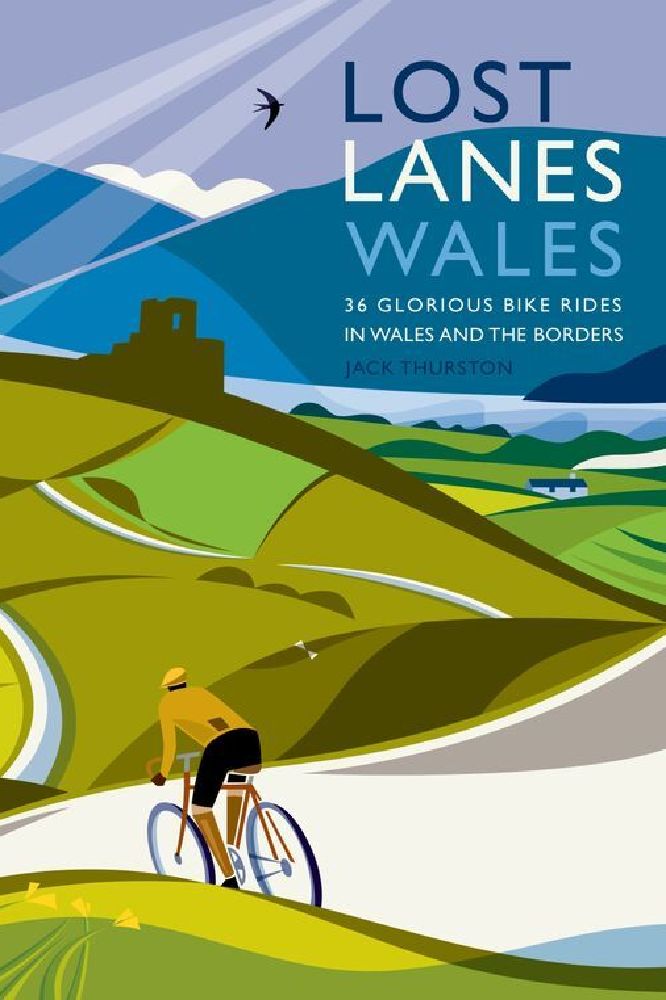Jack Thurston's new book Lost Lanes Wales: 36 Glorious Bike Rides in Wales and the Borders, explores the country's mountain summits, enchanted woodlands, wild seashores and ancient ways by bike. Here, he reveals his top ten reasons to embark on a green weekend of cycling in Wales:

Lost Lanes Wales
1. Huge sandy beaches.Wales has some of the biggest, best - and emptiest - swimming beaches in Britain. In Pembrokeshire try West Angle Bay and South Broadhaven or Abermawr, Abereiddy and White Sands Bay. In North Wales, the long strands at Harlech and Llandudno are popular with swimmers and kite surfers alike.
2. Mountains and lakes.Far hillier than its larger neighbour, Wales has some stunning mountain scenery. The highest peaks are in Snowdonia and you'll get a great view of them in several rides in the book, as well as the many lakes - both natural like Lake Bala and man-made reservoirs like in the Elan Valley - that sparkle in the sunshine. Further south, the Brecon Beacons rise in a dramatic crest from the steep sided south Wales valleys.
3. Local food and drink.Riding a bike means you work up a good appetite and the exercise means you can indulge it without worrying about your waistline. There are many traditional foods like cawl (lamb stew) to Welsh cakes and bara brith (a tea-infused fruit loaf) as well as artisan cheeses and cured meats. With a huge coastline, seafood is often on the menu too, from Conwy mussels to Llanelli cockles and laver bread from the Gower peninsular. The border counties of England too, are something of a gastronomic epicentre, whether its apples and Hereford beef to Cheshire cheese. Ludlow, St Davids and Abergavenny are three good places to begin a foodie odyssey.
4. Luxurious weekends away.There's never been a better choice of places to stay overnight, with a growing number of upscale hotels and boutique bed and breakfasts, often in historic buildings set in beautiful surroundings. For a truly luxurious weekend away stay at the New White Lion Hotel in Llandovery in Carmarthenshire, Ffynnon in Dolgellau in Snowdonia, the Angel Hotel in Abergavenny or the Stagg Inn in Titley, near Kington in Herefordshire.
5. Arts and crafts.Wales is in the throes of a revival in small-scale artisan making, from ceramics to wood turning to textiles. There are still a handful of traditional working woollen mills that are also open to visitors, making both traditional geometric 'carthen' (Welsh blankets) as well as more contemporary designs. The Mostyn gallery in Llandudno has just had a spectacular renovation with lots of new gallery space while the Museum of Modern Art in Machynlleth is always worth a visit, particularly for its permanent collection which includes the celebrated landscape paintings of Kyffin Williams.
6. Industrial heritage.The industrial revolution turned Wales upside-down, economically, socially and geographically. The rise of the south Wales valleys, first as the centre of the iron industry and later as a heartland of coal mining was astonishingly rapid and its decline over a few decades in the twentieth century almost as fast. A handful of industrial sites are well worth a visit, chief among them is town of Blaenavon in south-east Wales, home to "Big Pit" the coal mining museum staffed by former miners and an early ironworks. To the north, the Penrhyn Quarry in Bethesda once 'roofed the world' in Welsh slate, and is still working, but much reduced from its heyday.
7. Castles, forts and standing stonesMore than anywhere else in Britain, Wales and the borders is a land of standing stones, iron age hill forts and medieval castles, all of which make for great destinations for a bike ride. The northern coast of Pembrokeshire around Fishguard is dotted with standing stones, cromlechs and other remnants from forgotten Bronze Age civilisations and so too are the hills around Harlech, to the north. The borderlands between Wales and England are dotted with Norman castles and English king Edward I built an imposing 'ring of stone' in the north-west of Wales to defend his conquests.
8. Traffic free bike pathsCanals and railways built for industry have been turned over to leisure use and make great cycle routes. The cycle route into the heart of Snowdonia from the coast Bangor makes for a stunning ride, with towering peaks all around, while the Millennium Coast Path from Llanelli towards Kidwelly is a smooth, pan-flat, traffic free bike path along the coast.
9. Woods, meadows and wildflowers.Get your timing right and you may experience some of the most spectacular displays nature has to offer. In springtime lush green valleys of south east Wales are dotted with delicate orchids, cowslips bluebells and red campion. Pembrokeshire's rugged coastline is famous for its wild flowers, which are at their peak in late spring and early summer. High summer sees the Black Mountains and the hills of Shropshire and Radnorshire cloaked in rich purple heather. Later in the year, the countryside turns a gorgeous tapestry of red, gold and russet, and some of the most astonishing 'autumn tints' are to be found in Snowdonia and the steep-sided gorge of the lower Wye Valley.
10. Country pubs and inns.Despite the strength of nonconformist religion that often preached abstinence from alcohol, Wales has some great pubs. The Dyffryn Arms near Fishguard, is a traditional parlour pub, as is the Sun Inn in Leintwardine, just across the border in Herefordshire. Then there are the drovers inns, such as the tiny Sun Inn in Rhewl and the Bull's Head in Craswell near Hay on Wye, now a unique dining pub in the Black Mountains. The Clytha Arms in Monmouthshire is a perfect country pub serving well-kept local ales and home cooked food.
Lost Lanes Wales: 36 Glorious Bike Rides in Wales and the English Borders by Jack Thurston (£14.99, Wild Things Publishing) is available from all good bookshops. For 30% off and free P+P visit www.wildthingspublishing.com and enter 'Female' as your coupon code.

